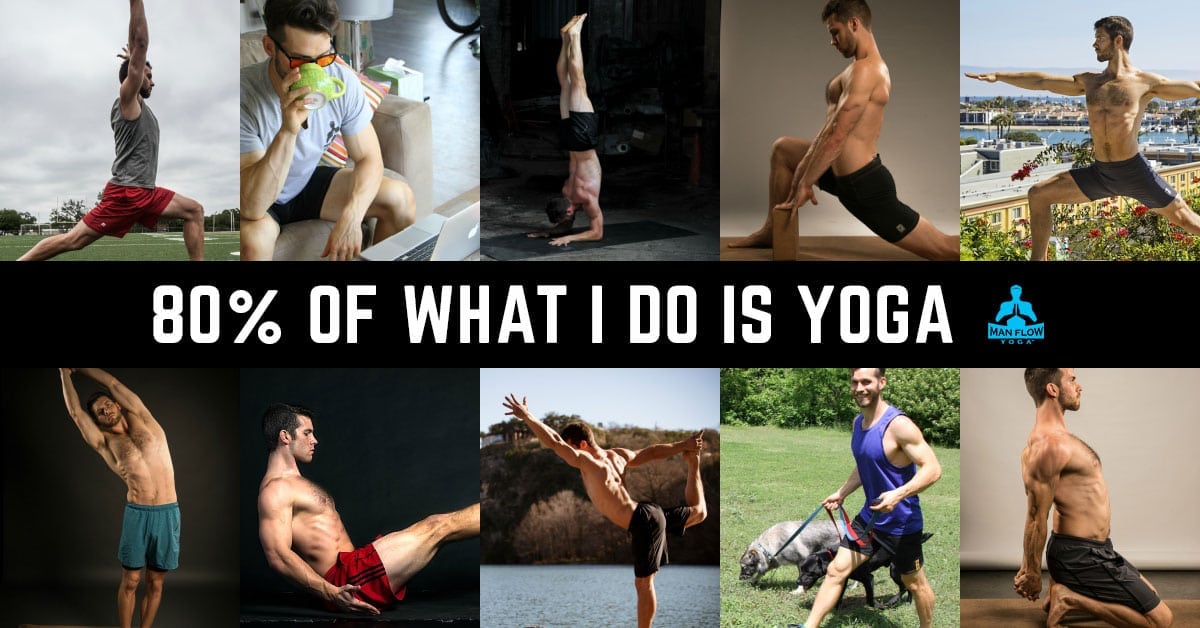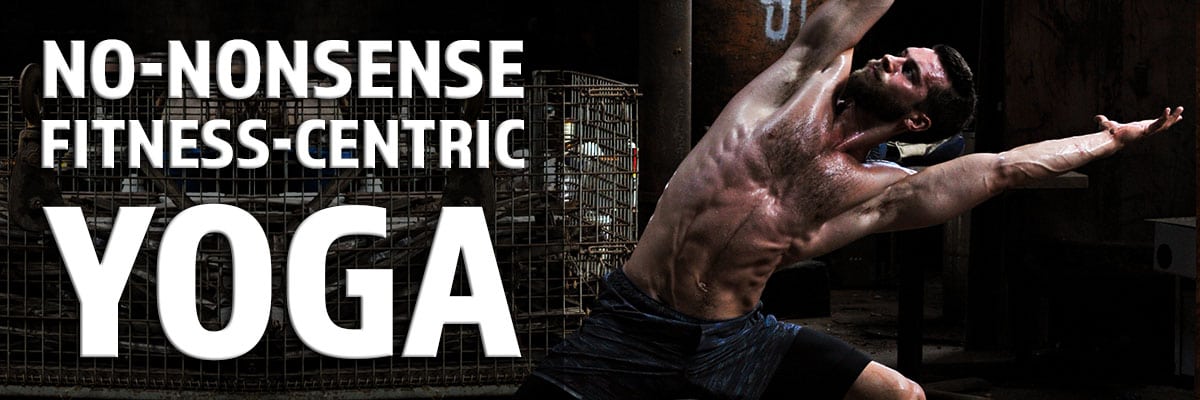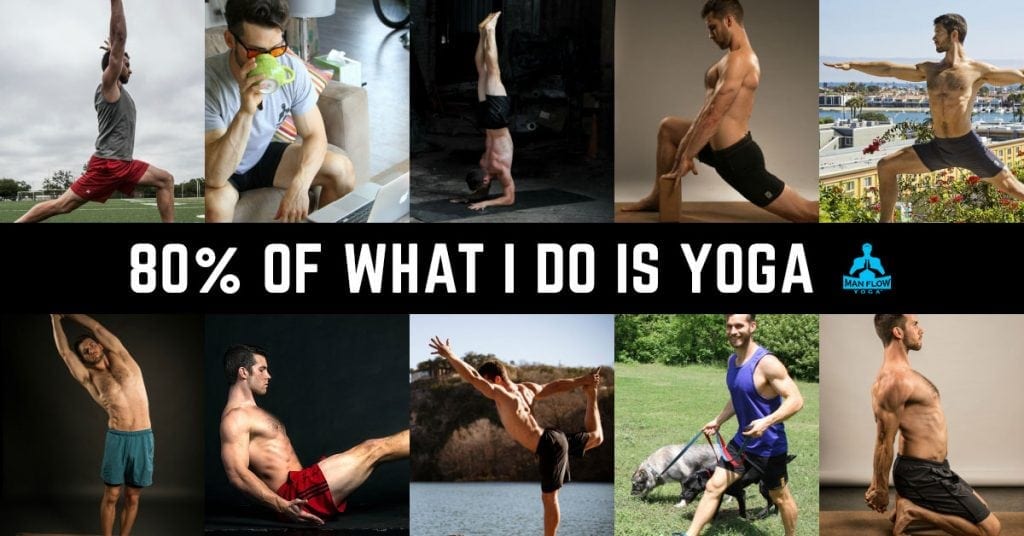
I’m writing this blog to answer the most commonly asked questions I receive:
- Is yoga all you do?
- What’s your workout routine?
- Can I really get the body I want with yoga?
My answer: 80% of what I do is yoga.
The answer is short, but that needs explaining.
When I say that 80% of what I do is yoga, it means that 80% of the time that I spend exercising is doing yoga. For every 1 hour I do something else, there are about 4 hours of yoga to counter it.
Even though yoga isn’t all that I do, there are a few reasons why that percentage is so high.
1. Yoga Sandwiching
One of the reasons for that 80% figure is that I add yoga into every aspect of my fitness. I do this with a format I refer to as “yoga sandwiching”.
Basically, I add yoga to the beginning and end of all of my workouts.
- If I’m going for a run, I warm-up with yoga, and I cool-down with yoga.
- If I’m going to lift weights, I warm-up with yoga, and I cool-down with yoga.
- If I’m going to play lacrosse, I warm-up with some yoga, then cool-down with yoga.
So, yoga takes a up a huge chunk of time because it makes up the beginning and end of my workouts.
2. “Yoga” refers to a LOT
When I refer to “yoga”, I mean any static (or slightly dynamic) exercises that resembles a yoga posture. I can add calisthenics into this general yoga category (such as lunges, squats, or push-ups – since all of these movements fall into that scope of yoga). I also add deep stretching and restorative stretching, such as longer-held lizard and pigeon stretches, to this list as well.
So when I say yoga, that refers to TONS of different exercises, many with distinct purposes and goals. Some are meant to improve balance and build endurance, while others are meant to promote restoration and help me sleep better.
The point I’m trying to make here is that there is no cookie-cutter format to what “yoga” is considered. There are many different styles and types of yoga.
And this brings me to my next point.
3. Not all yoga is intense
The next point I want to make is that even though 80% of what I do is yoga, there is only a fraction of that 80% that is made up of intense, muscle-building, sweaty, body-shaking yoga. I do about 3-4 hours of this intense yoga on a weekly basis.
Yoga done like this adds an incredible amount of strength, mobility, and overall body control to anyone’s fitness levels, but neglecting the more restorative side of yoga would be detrimental to your fitness.
(This intense type of yoga is exactly what the Yoga Body Program I just completed is based on. If you are reading this prior to May 1st, click here to sign up and get 15% savings on Yoga Body when it is released!
Aside from the warm-up and cool-down from the yoga sandwiching technique I mentioned earlier, the remaining 80% of the yoga that I do is yoga is focused on general body maintenance purposes, such as:
- Relieving sore muscles
- Getting muscle knots out
- Improving sleep
- Releasing kinks or “grinding” in my shoulders
- Speeding up recovery to get back to more difficult workouts more quickly
- Feeling awesome (fluid movement, no discomfort or pain)
There is absolutely an element of intense yoga you should be incorporating into your workouts, because there are certain movements in yoga useful for strengthening your body in ways that traditional exercise does not, but the other side of this is the more restorative aspects of yoga – the maintenance side; the part that ENABLES you to do the more intense stuff without being fearful of injury, having smooth and fluid movements, and approaching your workout with excitement instead of dreading moving your body (which is what happens when you’re chronically sore).
If you’ve done yoga before, you know what I’m talking about. Your body just FEELS better when you’re doing yoga.
But you don’t have to set aside an entire hour, or even 20 minutes, to do yoga – which brings me to my next point.
4. Sporadic yoga throughout the day
I do yoga throughout the day – not just in time specifically designated for workouts.
I’m taking a minute or so every 30 or 60 minutes to do a little bit of stretching, to move by body, to get up from the computer, take a break from work, and do yoga. This helps to realign my body, to counter the positions I’ve been in, and to help my mind refocus on what else needs to be done for the day.
I even do yoga while I’m working! Try balancing on one foot while you’re on a phone call. Do a lunge instead of sitting at your desk. Put your put on top of the desk for a hip stretch. There are tons of ways to incorporate yoga into your daily routines.
One of the reasons for this sporadic yoga is physical – I just feel better when I’m stretching and moving, instead of staying still. But beyond that, there is also a mental aspect.
There is an incredible link between your body and your mind. When your body wakes up, so does your mind. When your body is stressed, so is your mind. For me, movement has always come easy, so in order to refocus and clear my head, exercise is the answer.
I add these tiny workouts into the day not just because it helps my body feel better, but also because it enables me to be more effective at everything else I do, from my mental performance to my ability to empathize.
I mentioned that movement has always been easy for me, and that’s because fitness has always been a part of my life – way before I found yoga. And that leads into point #5.
5. Yoga is just one part of my fitness goals
The last point I want to make is that my yoga workout is just one part of my fitness. I lift weights, do, weighted pull-ups, sprint, and play high-impact sports (more accurately, I play a single high-impact sport – lacrosse).
These workouts have different effects on my body than my yoga workouts do. The goal of these workouts is to put my body through a high level of stress, to prepare my body for the high-impact aspects lacrosse.
These higher-impact, dynamic exercises are very effective, but they require a lot of time to prepare for. I can’t just start sprinting without any warm-up. I need to make sure that all of my muscle groups are firing, that my body is turned on and active, and that I have no muscle knots are muscle tightness holding me back. I also have to cool-down, or I’ll be unnecessarily sore the next day.
This is where yoga comes in. Yoga enables me to be able to these exercises.
The only reason I can continue to do all of these other high-impact, dynamic exercise and feel as good as I do is BECAUSE I’m doing yoga. If I did not take the time that I do to strengthen my body, stretch sore muscles, activate my parasympathetic nervous system, and just in general take care of my body with the stretches and postures found in yoga, I would not be able to do the more high-impact workouts as well, and I’d be at a much higher risk of injury.
On the flip side, ONLY doing yoga is can also be dangerous.
In 2014, I had a serious knee injury as a result of a yoga-only training regimen that took me out of yoga and running in general for over 6 months. I felt great when I was only doing yoga, but my body was unprepared for the stress of lacrosse. I learned my lesson – yoga was not a panacea, and based on the physical activities I wanted to participate in I would need to train accordingly.
(Aesthetically, I also lost a few more pounds of muscle than I hoped for. While my legs, core, and chest were still very strong, my arms, upper-back, and shoulders were not as strong as as large as they had once been. When I started lifting weights again, I was able to add back on that lost muscle mass, and the lifts felt WAY better than they ever had before, thanks to the yoga.)
To summarize my last point, you have to exercise according to your fitness goals. For you, that could be 100% yoga. Or it could be 20% yoga. I strongly believe that ALL of us benefit from a regular yoga routine, whether we are training for a triathlon, playing professional sports, or just want to improve our health and lose a few pounds. It only takes a few minutes per day to get started. JUST DO IT. (Need help getting started? Take my FREE, brand new 7-Day Intro. Click here to sign up!)
Here’s what I want you to take from this:
Fitness isn’t all about exhausting your body as often as you can. The majority of your exercise should be maintenance and injury prevention for your body. Your exercise should FEEL good – not hurt you.
At the same time, you also need to push your body. Depending on your fitness level, that means different things for different people. Yoga might be plenty of push for you. Or, you might need weights and higher impact to add a significant challenge. It’s up to you to test things out and determine how much you should push, and also to learn when you’ve pushed too far.
No matter what your level of fitness is, you’re going to need some variation of yoga if you intend on keeping your body healthy and performing at optimal levels. If you want to get straight into it, Man Flow Yoga is THE yoga for fitness resource. We have workouts, programs, and tutorials to help you make yoga a habit. Click here to sign up for a 7-Day Trial – you get unlimited access for just $1.
A final personal note: My goals are different from most people’s. In order to confidently play high-impact sports without fear of injury, I need to do more than just yoga and bodyweight exercise. If your goal is to look and feel good, but don’t need to worry about running full speed and colliding with another human being, you probably don’t need a whole lot more.
Secondly, this is my job. In addition to all of the writing, customer service, and general computer work that I do, I also spend a lot of my time doing yoga and exercising. I’m teaching lessons, recording videos, and demonstrating poses anywhere from 30 minutes to 3 hours per day, which means I spend WAY more time exercising than most average people have time for. It’s great, because I get to move, have energy, and enjoy my work, but it also means that my body gets put through more physical stress than most people experience, and I have to do more restorative work in order to take care of my body. (It also can detract from the energy required for my other workouts.) In short, there are pros and cons to exercising more often throughout the day, but it definitely has a significant impact on what your own personal workout routine looks like.
Ready to get Started?
Learn More About Man Flow Yoga and how it can help you with your fitness goals: MY #1 FITNESS RESOURCE!
MY #1 FITNESS RESOURCE!
Two things I would add here.
One, is to have a clear sense of why you’re doing all this fitness stuff at all. Particularly if you are a not a fitness guru like Dean, or indeed a sportsperson.
Once your goal is clear, then you can map out a working strategy which also incentivises you to stick to it (because even when it sucks to do it, you have a clear reason to carry on doing so, or to adapt it, or to take a break! Because you know where you’re going with it).
Two: “fitness” for human beings is threefold. It’s mental, and emotional, as well as physical. So keep your perspective, and don’t use one to substitute for another. (Yoga can help in all three, which is another reason it’s so useful as part of your exercise regimen).
Good ideas, Richard!
I think getting the balance right with training is always difficult. Personally I have moved to a more Yoga focused training program as I think it provides the most variety while still allowing me to achieve my training goals. I have found a good balance between vinyasa flow and restorative yoga. It has allowed me to develop my yoga practice but has also helped me avoid any serious injuries. I also cycle most days, do functional strength training and play tennis regularly and yoga has aided me in all of them. I would say 60 to 70% of what I do is yoga and I am very happy with the results!
That’s awesome, Thomas!!! Thank you for sharing.